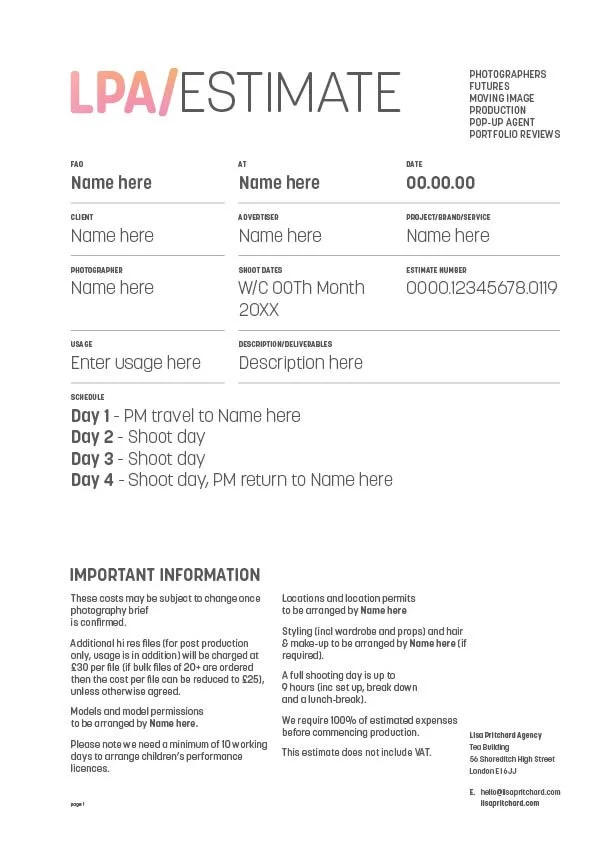How to Commission a Photographer / Part 6: Photoshoot Contracts
Part 6: Photoshoot Contracts: Photographers terms and conditions.
What I thought I’d do in this part is try to set out in plain English, the main clauses in our terms and conditions - clauses which are likely to pop up in most photoshoot contracts.
Our business terms are the legal terms upon which we agree to do business and form a contract, we’d be exposing ourselves to too much risk if we didn’t have them. Agreeing to provide photography, with or without the whole shoot production service and the liabilities that comes with that, is a big responsibility both financially and legally. Our business terms protect our rights and limit our liabilities. As well as that, they can be viewed as a set of clear guidelines, ‘ground rules’ if you like. Their main purpose is to prevent any disputes as expectations and responsibilities are clearly set out from the onset, in writing.
We send out a full set of our terms and conditions with our estimates and our invoices, and of course, we will be happy to send them to you directly if you wish (just pop us an email). We often receive contracts back from our clients with very similar contents, occasionally there is some disparity or conflicting clauses, but most of the time, clients’ terms of business are very much along the same lines and everyone thankfully is ‘singing from the same hymn sheet.’
Having said that, there is one key issue that crops up time and time again, and that is the subject of copyright. Clients sometimes ask us to assign the intellectual property in the images, which in effect includes the copyright of the images. The other two ‘usual suspects’ where there is an occasional clash are payment terms and indemnity. Again areas that, when we explain what is acceptable and why are usually resolved pretty easily. Now I might be setting myself up for a fall here, but these are the only areas where there has ever been any incongruity. More on these three areas later.
Here at LPA, we lay out the specifics relevant to the job in hand on the front page of our estimate before the figures and we include our general set of terms of business on the last page. Specific information like shoot dates, description of the shoot and who the client is, form as much an important part of our contract as our general ‘small print’.
So we include:
The Date. The date of the estimate or invoice.
The Client. Who this contract is with.
The Advertiser, Brand or Product. Often our shoots are for a particular brand or product, as opposed to a whole business and all the brands they encompass.
An Estimate or Invoice Number.
Description/Deliverables. This sums up what we have been asked to do and deliver. E.g Description of shoot and amount of images.
© Alexis Ko / 7UP
The Date (s) of shoot.
Usage. This states how, when and where the images can be specifically used (see Part 4: The Cost of a Photoshoot)
(Other) Important Information. We also like to clarify other important information on the first page of our estimates to avoid misunderstandings and state extra clearly who is responsible for what.
After we have set out the figures we follow with our ‘small print’.
The main clauses we include are...
Definitions: Firstly we define any common words or phrases that are used throughout the contract to avoid misunderstandings. For example: ‘Days’ are working days and 9 hours.
Copyright and Ownership of Materials: One of the most important clauses on any photography contract. Our terms (as with most photography contracts) state that the copyright should always remain with the photographer and that a specific usage licence as outlined on the estimate has been granted.
As I mentioned earlier this is one of the few clauses that is met with any disparity. We sometimes get client contracts that request an assignment of intellectual property rights. However, in my experience 99% of the time, this is because the client is using a blanket contract that is not particularly geared towards photography, but towards other creative suppliers. So what they are actually asking for is that the creative agency, or maybe it’s a freelance designer or creative team, for example, assign their IP (intellectual property rights), e.g the design they have created for the brand. The other reason clients sometimes ask for copyright is down to a slight misunderstanding of the term. What commissioners usually just want to know is that they can use the image/s for anything and everything to do with the product or service it was shot for in the first place, without having to keep coming back and asking us to extend the usage licence. This would be termed as a usage licence for ‘all media, in perpetuity, worldwide’ and quite different from an assignment of copyright. The latter in effect would allow the client to sell on the images to any third party. I’ve yet to come across a commercial client who actually wishes to do that.
Usage: We clarify that the usage is restricted to that stated on the estimate and to the advertiser, brand or product only. Additional usage needs to be agreed and no usage can be made without full payment. We also state that usage begins from date of first use or 6 months after shoot date whichever is sooner. We also like to include here that, unless an embargo is made at the time of commissioning, the photographer and LPA are free to use their images for their own self-promotion.
Indemnity: We set out on our terms that we are only responsible for third-party clearances if it has been expressly agreed in writing. Now, if it has been agreed that we are organising models and locations (which we would state in ‘important information’ see above) we would of course take responsibility for getting releases and permits.
© Patrick Harrison / Sutton Forest School
Occasionally we see contracts from clients that ask us to indemnify them against all third-party claims, losses or damages as a result of the shoot. As you can hopefully appreciate this is rather unfair and something we wouldn’t feel comfortable agreeing to. Say the ‘models’ were staff of a big company and the client claimed they were going to deal with the model releases but didn’t, then years later when one of the ‘model’s had moved to a different company they wanted to sue because their images were still being used, we wouldn’t want to expose ourselves to that liability!
Having said that if your contract clearly requests that we indemnify you against a breach of the contract by us then that’s a different matter.
Payment Terms: Our payment terms state 30 days which is pretty industry standard. Some clients ask for 90-day payment terms, this is not acceptable, especially if we have to fund expenses before the shoot. In this case payment terms of everything aside from photographers fee and basic photographic expenses is actually immediate (see Part 5: Timings)
Estimate: Just to set expectations straight we make reference to the fact that it is the client’s responsibility to check the estimate to ensure all requirements are included, things such as post-production, hi-res files, usage licences and technical specifications for the images, for example.
Contingency Budget: We clarify that if we are asked to do more than is originally agreed or the brief changes then the client will need to cover any additional costs incurred as a result of this.
Overtime: Should the client request the shoot to go over the usual working day we will be liable for overtime charges for crew and other shoot suppliers, not to mention the fact that it’s only fair that the photographer get paid more for his time (within reason)
Anti-social hours: If a shoot is required during ‘anti-social’ hours, i.e outside 9 a.m to 6 p.m, or weekends or bank holidays.then premium rates may be charged.
Rejection: Fortunately it is extremely rare that a client isn’t happy with the end result. In the many years I’ve been doing this, this has only happened twice on any shoot I’ve dealt with. Both times it was because there wasn’t an art director on the shoot or the brief wasn’t made clear. We factor in the following line now to protect ourselves. “If the Client is not present during the shoot then the photographer’s interpretation of the brief is deemed acceptable. Unless stated in writing on the day of the shoot, there is no right to reject on the basis of style or composition unless otherwise agreed’’.
Cancellation/Postponement: Once a shoot has been confirmed, with a purchase order or in writing, we then confirm the photographer and crew and start committing to other shoot expenses. If the shoot is for some reason then cancelled, we could be out of pocket and/or the photographer and crew could have turned other work away.
So, for this reason, we have cancellation terms for fees and expenses incurred. The nearer to the shoot (i.e the less warning time) the bigger percentage of fees are payable, e.g 100% if just 24 hours. Of course, we will always try to be flexible if the shoot is postponed, but you can imagine what havoc and expense can be caused if shoots keep moving around.
Third-Party Rights: We are often responsible for third parties, models and crew and so to protect ourselves we like to limit our liability. For example, part of this clause states that the ‘Photographer or LPA takes no liability for model fees incurred due to additional usage of images above and beyond the usage stated on the final invoice. It is the client's responsibility to contact models/model agents directly unless otherwise agreed.’ We sometimes get calls from models who have seen themselves on billboards or Point of Sale material when the usage has expired for example. Of course, we will always try and resolve the situation by negotiating additional usage fees and have a responsibility to the photographer to do so in terms of their fees, but we don’t want to ultimately be responsible for the models or the client if the situation becomes problematic or unresolvable without resorting to a legal case.
© Jack Abbott / Visit Wales
That’s pretty much it, all fairly straightforward as you can see!
If we receive a contract from a client with terms that we feel aren’t acceptable ( and it really is just mostly those three areas I mentioned above and mainly the misunderstanding surrounding the term copyright) then we would be more than happy to suggest alternative wording so it aligns with our terms. At the end of the day, we just want to find a mutually fair agreement so we can get on with the exciting business of the shoot!
Sticking with the serious stuff next week, stay tuned for Part 7: Photoshoot Legal Obligations and Codes of Conduct. Essential information on shooting people, places and things.
Although the author has made every effort to ensure that the information in this blog post is correct, the contents are provided without warranty as to their accuracy, may be of a general nature and the opinion of the author only. The author will not be held responsible for any loss, damage or disruption caused by errors or omissions, whether such errors or omissions result from negligence, accident, or any other cause.
The images used in this article are for illustrative purposes only and do not necessarily correlate with facts stated in the text.
This article is not intended as legal advice, the information is simply to give helpful guidance and is the opinion of the author only. Please use your discretion before taking any decisions based on the information in this article.You are strongly advised to seek the advice of a professional lawyer on all matters of business terms and conditions and photoshoot contracts.




